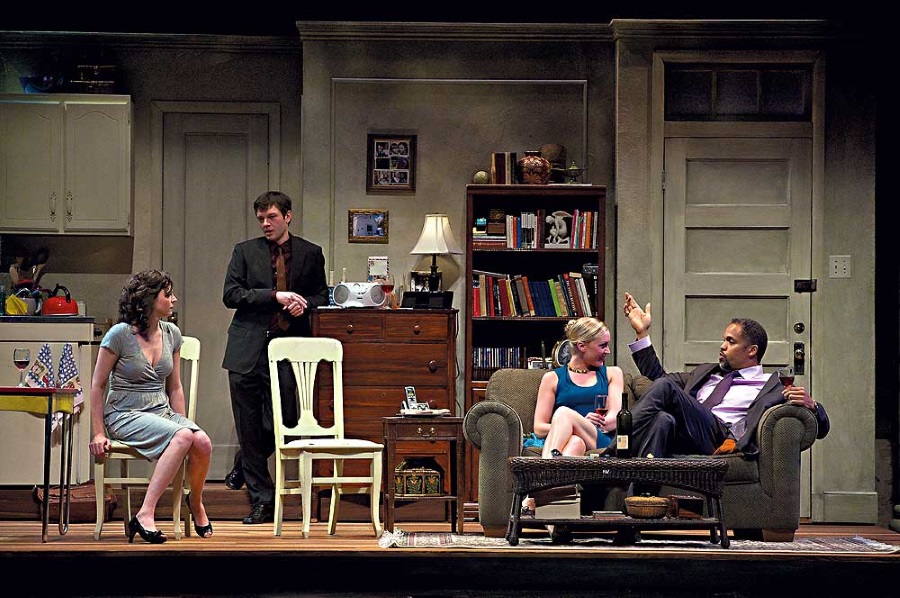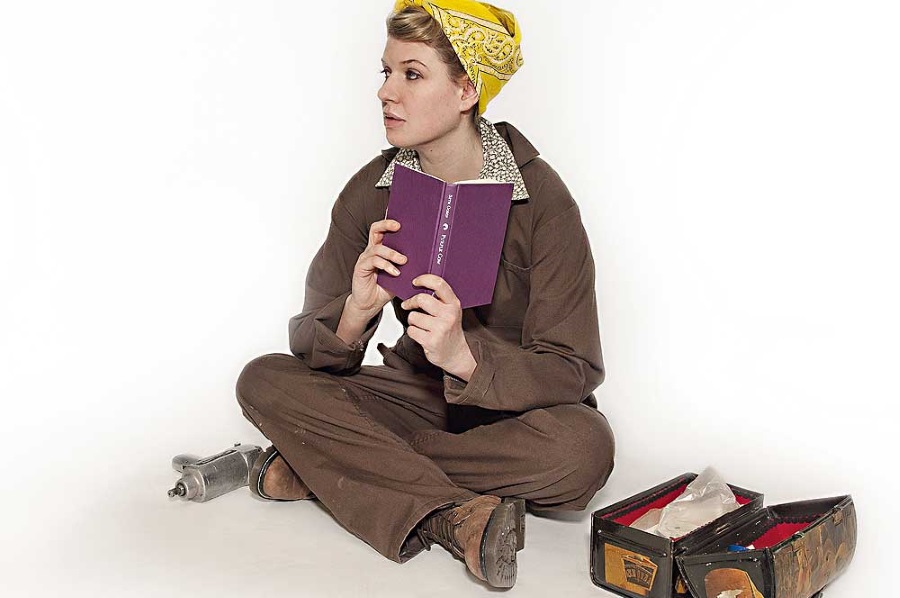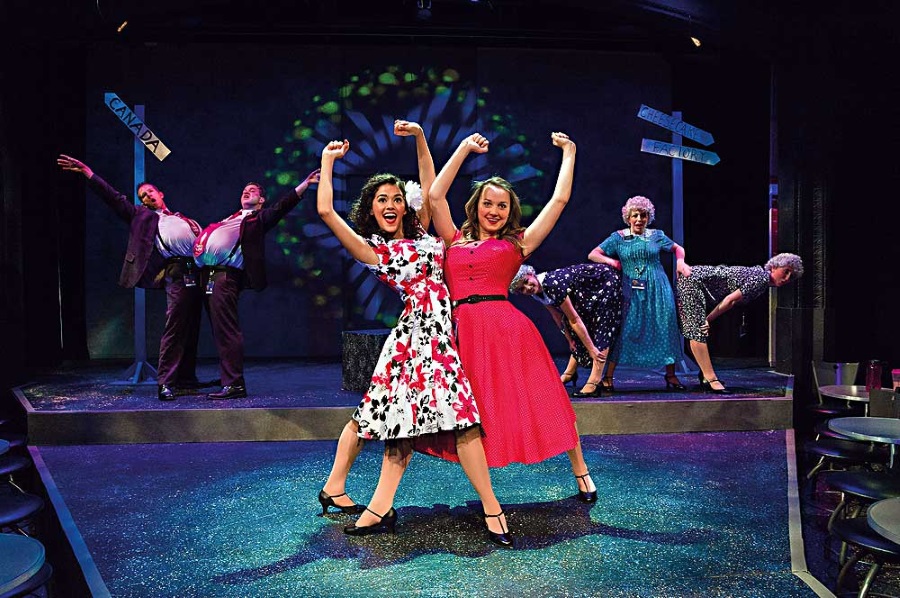When I tell people I meet that I am a theatre critic from Salt Lake City, they invariably ask two questions: Am I a Mormon? And is there any theatre in Salt Lake City? The answers are no and yes. There definitely is theatre in Salt Lake City, and it is surprisingly good.
“The first thing anyone who comes here notices about Salt Lake is that its support for the arts is far greater per capita than probably any other city of its size in America,” observes Chris Lino, managing director of Pioneer Theatre Company, the city’s flagship LORT theatre. Lino thinks there are two reasons for this: The Mormons who founded Salt Lake placed a high value on the arts, and that impulse endures; furthermore, the city was a community in the wilderness, which means people had to create the art themselves. “That has resulted in a more vibrant performing arts community in Salt Lake City than one would expect of a city of this size,” Lino believes.
Cynthia Fleming, who serves (along with Keven Myhre) as executive producer at Salt Lake Acting Company, agrees: “There is such an abundance of creative energy in this city, whether it’s theatre, dance or art. People who come from out of state are amazed.”
Fran Pruyn, artistic director of Pygmalion Productions, describes theatre in Salt Lake—and its audience as well—as “bipolar,” part conservative and part liberal. “We have a huge population of attendees that stick to safe, traditional offerings by companies like the Hale Centre Theatre,” Pruyn explains. “These conservative citizens are often members of the predominant faith, who love live theatre but might be offended by playwrights who challenge conventional thinking or use challenging language. What is important is that these individuals support live theatre and do so consistently.
“There are also a number of companies like ourselves who revel in more progressive work and cater to the outspoken and activist members of the community,” Pruyn continues. “The houses are smaller, but the audiences for SLAC, Plan-B Theatre Company and Pygmalion are all devoted and eager to explore new ideas.”
Local playwright Jenifer Nii describes the balance this produces: “Alongside companies doing current and really brave work, we also have companies that provide wonderful musicals that are standard and family-oriented. I think that might be rare in the United States today—to have that kind of balance.”
There is a downside, however, which Lino points out: “There’s an enormous amount of theatre in this town, but in most cases, it comes with small audiences.” Nevertheless, a number of the city’s smaller theatres are firmly dedicated to taking risks and producing edgy work, and what’s most impressive is the sheer amount of new work being produced—much of which is by local playwrights, a large percentage of them women.
In fact, the 2011–12 Salt Lake theatre season might have been dubbed “the year of the women playwrights.” PTC debuted Wendy McLeod’s Find and Sign; Pygmalion reprised Julie Jensen’s Last Lists of My Mad Mother; SLAC premiered Elaine Jarvik and Kate Jarvik Birch’s (a man enters); and Plan-B did an entire season of plays by women: Aden Ross’s Lady Macbeth, Debora Threedy’s The Third Crossing and Jenifer Nii’s The Scarlet Letter.
Among the city’s big four theatres, only PTC feels iffy about new work—the company aspires to do more of it but feels restricted by the economic reality of having to consistently fill 932 seats.

SLAC, which began its life in 1970 in the basement of Salt Lake’s Unitarian Church, today occupies an historic LDS Church ward house in the Marmalade Hill neighborhood. It operates two theatres—the 200-seat Upstairs Theatre and the 99-seat Chapel Theatre. SLAC is dedicated to producing world and regional premieres of contemporary American plays, and has staged more than 200 of them in its 43-year history. Three of its playwrights in residence—Al Brown, J. T. Rogers and Julie Jensen—have been supported by grants from Theatre Communications Group, resulting in commissions and/or productions of three plays by Brown, four by Rogers and six by Jensen. “For a company our size to get that award for three different playwrights is amazing,” comments executive producer Myhre.
“SLAC is rare in regional theatres in that it doesn’t mix new plays with old favorites—its whole season is new work,” says Utah playwright David Kranes. “And there’s a commitment to local playwrights. That’s quite remarkable.” Kranes, who inaugurated and led the Sundance Playwrights Lab for 14 years, had five plays produced at SLAC during the 1980s and ’90s. In the past four seasons, SLAC has premiered three plays by current playwright in residence Kathleen Cahill, all of them developed in the company’s 19-year-old New Play Sounding Series, a program spotlighting local writers.
What SLAC is most famous (or infamous) for locally, however, is its annual production of Saturday’s Voyeur. For 35 years, Nancy Borgenicht and Allen Nevins have churned out varied editions of this original musical comedy that satirizes and celebrates the unique cultural and political experience of living in Utah. Voyeur runs for most of the summer, and its popularity underwrites and builds an audience for the rest of SLAC’s season. “This is where we get our audience for these new plays,” Fleming admits. “They come to this place, they hear this voice that is so raw and true and funny—and then we say, ‘Hey, look, we have other voices that are raw and true and sometimes funny, sometimes not. Come see them.’ And they jump in and embrace this new work. I don’t know if there is a theatre company in the nation that has something like this.”
Tobin Atkinson and Cheryl Ann Cluff founded Plan-B in 1991. The company’s mission is to “develop and produce unique and socially conscious theatre, with a particular emphasis on new plays by Utah playwrights.” Seventy-one of the 96 plays that Plan-B has produced have been premieres. During the past eight seasons, Plan-B has staged almost exclusively plays by local playwrights, including Eric Samuelsen, Aden Ross, Tobin Atkinson, Carol Lynn Pearson, Debora Threedy, Mary Dickson, Matthew Ivan Bennett, Jenifer Nii, Julie Jensen and Matthew Greene. This season the company will produce an entire slate of Samuelsen’s work.
“We’re developing relationships with playwrights more than with plays,” specifies producing director Jerry Rapier, who took over Atkinson’s role when he moved to Washington, D.C., in 2000. “We’re not just randomly choosing plays; we’re commissioning work or saying, ‘What do you have that we can look at?’”
“Plan-B was the catalyst for the development of work especially focused on issues pertinent to local audiences,” says Jenifer Nii, who writes solely for the company. “That I think is unique in the country—to raise questions about current and historical issues that affect the daily lives of the audiences that are seeing them, things they might not read in a textbook but come alive through theatre.”
Two Plan-B productions that did this quite effectively were Facing East by Carol Lynn Pearson in 2006 and Exposed by Mary Dickson in 2007. In Facing East, a mother and father try to come to terms with the suicide of their gay son, whose lifestyle their religion kept them from accepting. Exposed tells the story of a number of “downwinders,” Utah and Idaho residents whose lives and health were compromised by nuclear testing at the Nevada Test Site. The latter play focuses on the relationship between the playwright and her sister, who eventually died from lupus.
Facing East, Exposed and Borderlands, a Samuelsen play that explored LDS issues, all created “theatrical experiences on their own terms with people who had something to say that only they could say, and only a certain audience would hear,” according to Rapier. Exposed toured throughout the state, and Facing East had runs in both San Francisco and New York, where it received good critical and audience response.
As an outsider who moved to Salt Lake City 10 years ago, Cahill has some interesting insights on the playwright’s place here: “Because of the culture and religion, playwriting tends to say things that no one else will say and be about things that no one else will speak of. It’s one of the few cities where there are still taboos, and those are the things that SLAC and Plan-B deal with—they touch on the things that are still hot-button issues in Utah that maybe aren’t like that in other states, so it matters. The playwright has a very special voice here.” Cahill says living in Utah has been liberating for her as a writer because “I had something to bang up against.”

Pygmalion began in Ogden, Utah, in 1995. Founders Nancy Roth and Reb Fleming moved the company to Salt Lake in 2005 because they felt the city offered a larger, more receptive audience for their work, which is designed to “reflect issues, concerns and shared experiences in the lives of women.” Fran Pruyn, who became involved shortly after that, notes that Pygmalion fills an important niche in the community—ironically, although many playwrights in the American theatre are men, audiences are predominantly female. Pygmalion’s programming over the past five years has included such home-grown work as The Passion of Sister Dottie S. Dixon by Charles Lynn Frost and Troy Williams; Elaine Jarvik’s The Coming Ice Age; Matthew Ivan Bennett’s A Night with the Family; and Cheat and Last Lists of My Mad Mother, both by Julie Jensen.
PTC got its start in 1962. During its early years, the theatre produced primarily mainstream musicals, but when Charles Morey became the artistic director in 1984, he pushed for a better balance of classic and contemporary plays and edgier musicals. PTC was the first regional theatre to stage Les Misérables, which it reprised last season to sold-out audiences. Morey retired in 2012, and Karen Azenberg is the current artistic director. It had long been Morey’s dream for PTC to have a new-play program, and during the last three years of his tenure, the theatre commissioned and produced three premieres: Touch(ed) and In by Bess Wohl, and Find and Sign by Wendy McLeod. The program, though, is currently suspended.
Chris Lino explains that he and Morey knew from the start that a theatre of PTC’s size is not the right place to develop and premiere new work, which frequently needs an intimate setting. “We can do a lot of things really well on the Lees Main Stage, but intimate isn’t something that comes naturally,” Lino says. PTC needs to find a smaller space to make new-play development viable, and right now there isn’t one. Nevertheless, PTC is planning on resuming new-play readings this season.

PTC is not the only theatre that needs a more viable smaller space. A number of promising alternative theatre companies are struggling to survive because they have nowhere in the city to perform. The advent in 1997 of the Rose Wagner Performing Arts Center—with its 500-seat Jeanné Wagner; the Leona Wagner black box, which seats about 200; and the intimate Studio Theatre with seating for about 75—was a gift to local dance and theatre companies. Pygmalion and Plan-B are two of the six resident companies at the Rose (there are also three dance troupes, along with the Gina Bachauer Piano Foundation), and Pruyn says the center’s impact has been enormous. “It has created a community of artists that support each other’s work,” she says. Rent at the Rose is quite affordable since it is run by Salt Lake County.
The problem is that it’s not enough. The Rose is completely booked, and a lot of performing arts companies remain homeless. The city is currently planning on building a new 2,500-seat theatre to house Broadway touring shows. Since Salt Lake already has two facilities that stage touring shows, the local arts community sees no need for another, but Mayor Ralph Becker is convinced it will help revitalize downtown. After much agitation, the city has agreed to include some smaller performance spaces for local groups in the new theatre, but this concession only sidesteps, rather than addresses, the limited-space issue.
Another recent addition to the scene is Atkinson’s own Meat & Potato Theatre, for which he and his wife, Marynell Hinton, create one completely original production a year in the Studio Theatre at the Rose Wagner. In 2011, Atkinson staged his adaptation of Homer’s The Odyssey with five actors and minimal costumes and scenery. A rich sound design and storytelling propelled the production, which demanded that audiences use their imaginations and become part of the process—and they responded. ALIENS: The Puppet Musical followed in 2012. The show sold out its run and became an instant cult classic.
Ask local playwrights what they like about living and working in Salt Lake City, and you get a variety of responses: Matt Bennett says, “It’s my city. I’ve had the experience of going other places and seeing my work, but most important to me is that it be seen here.” Debora Threedy adds, “It’s a very supportive, collaborative environment. A lot of the theatre groups go out of their way to support one another. That’s probably a little bit of Utah niceness.”
Samuelsen points to the expertise of his fellow writers: “There may not be as many of us as there are in New York, but the level of talent is astounding.” Jensen likes the supportive audiences: “People are as enthusiastic about new plays by local writers as they are about old plays by dead people—there’s an attitude among audiences that is really encouraging.”
Cahill gets the final word: “There is an openness here—an openness in the West and a lack of snobbery.”
Whether it’s the spectacular setting with its mountains and room to stretch and grow, or the willingness of the people to support dreamers, even if they don’t completely understand their dreams, the result is plain: Salt Lake City’s theatre can hold its own.
Barbara M. Bannon has been covering theatre for various publications in
Salt Lake City for 35 years. For the past 10 years, she has been the
freelance theatre critic for the Salt Lake Tribune.


